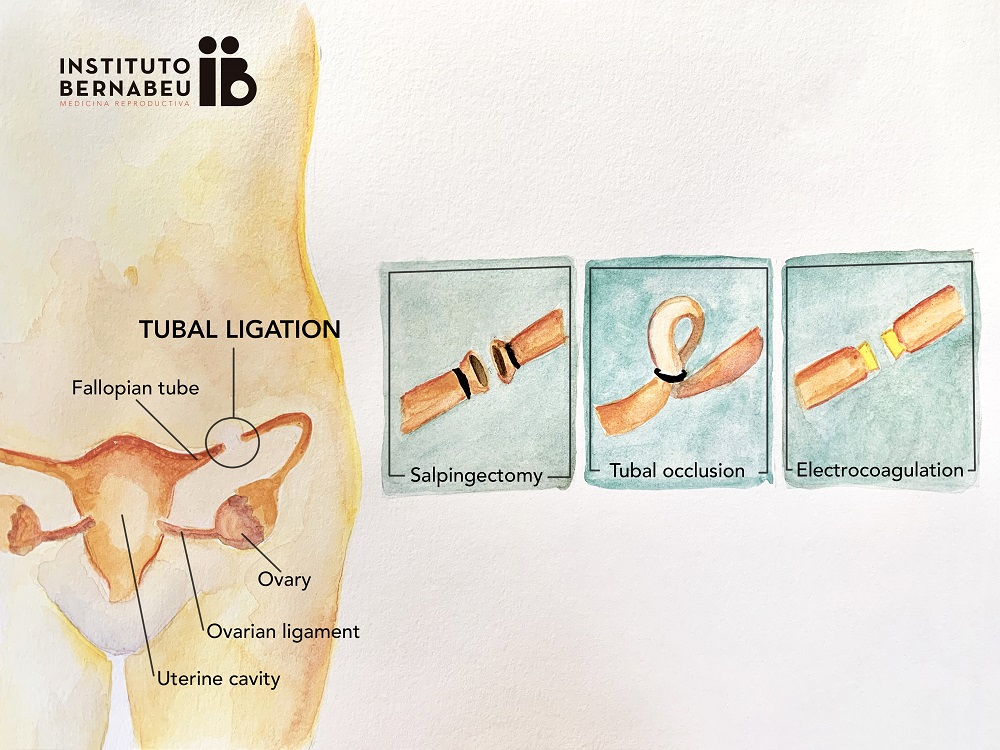
What does tubal ligation entail? The advantages and disadvantages of this method of birth control
Tubal ligation (also referred to as bilateral tubal occlusion) is a permanent method of birth control. It consists of blocking off access to the Fallopian tubes to avoid the ovum being fertilised by a spermatozoon.
Índice
How is tubal ligation performed?
Blocking off the Fallopian tubes has to be performed by means of surgery. It is a swift process that takes no more than 30 minutes and it can be performed as indicated below:
- Laparoscopy. This is the most commonly-used technique. It entails making one or two small incisions in the abdomen and inserting a very small camera (laparoscopy). The surgeon uses the camera to observe the uterus, Fallopian tubes and ovaries and to seal off the Fallopian tubes.
- A laparotomy procedure can sometimes be used to perform the ligation (if performed at the same time as a caesarean section).
There are different techniques for tubal sterilisation:
- Partial salpingectomy (the Pomeroy technique).
- Tubal occlusion using a compression ring (Young) or Hulka clip.
- Cauterisation by means of electrocoagulation.
Until recently, another method using hysteroscopy was used. It entailed positioning a spring in each tube (Essure). It has is no longer in use because of its association with undesirable side effects.

What are the advantages of tubal ligation?
- The main advantage of tubal ligation is that it is incredibly effective. The technique has a rate of up to a 99.5% reliability and this figure actually increases after the first year.
- Another, and no less significant, advantage is that it is a relatively simple intervention. Patients can return home after just a few hours’ in hospital.
- The procedure does not affect ovarian or uterine function. As such, the menstrual cycle persists and patients continue to have periods. Furthermore, it does not alter when the woman will go through the menopause.
- If everything goes as expected, no posterior medical check-ups and appointments are needed.
What are the disadvantages of tubal ligation?
- Reversing tubal ligation is complex and not always effective. It depends on the occlusion technique used and the time that has passed since the surgery was performed. That is, it is not always possible. Furthermore, even when it is performed, the chances of conceiving once again naturally are very low. Therefore, if a woman wishes to have children once again, in vitro fertilisation is advised. By doing so, the role of the Fallopian tubes in fertilising the ova can be bypassed and the entire procedure can be performed in a laboratory. Patients need to undergo ovarian stimulation in order to retrieve ova and male partners must provide a semen sample. The prognosis is generally favourable in these cases. Find out more by clicking on this link: having children after tubal ligation.
- As with all other existing means of birth control, it is not 100% effective. It is a reliable method but it isn’t fail-safe. Most recent studies have recorded a failure rate under 1%.Whilst it is incredibly unusual, the ends of the Fallopian tubes can join together once again and lead to an unwanted pregnancy. There is also an increased risk of an ectopic pregnancy (pregnancy outside the uterus).
- The most common side effects are linked to the surgical technique itself and the general anaesthetic.
- It does not protect against sexually transmitted diseases.
Are there alternative birth control methods?
In recent years, there has been a trend in favour of vasectomies, given that it a simple and definitive procedure.
There are numerous alternative birth control methods. Some, such as the intrauterine device (IUD) or subcutaneous hormone implants in the arm are very efficient. They are long-term solutions that can easily be removed. Each have their own pros and cons and, for this reason, the decision on the most appropriate method for each person’s needs should to be taken in conjunction with the gynaecologist. Use this link to find out more about birth control methods.
[yframe url='https://www.youtube.com/watch?v=wYSQt_z_Ke0']IT MAY ALSO BE OF INTEREST TO YOU:
- Is it possible to become a mother after tubal ligation?
- How do male and female contraceptives affect my fertility?
- Vasectomies: the male contraceptive
- Ectopic pregnancy
Dr Ruth Romero, a gynaecologist at Instituto Bernabeu.
